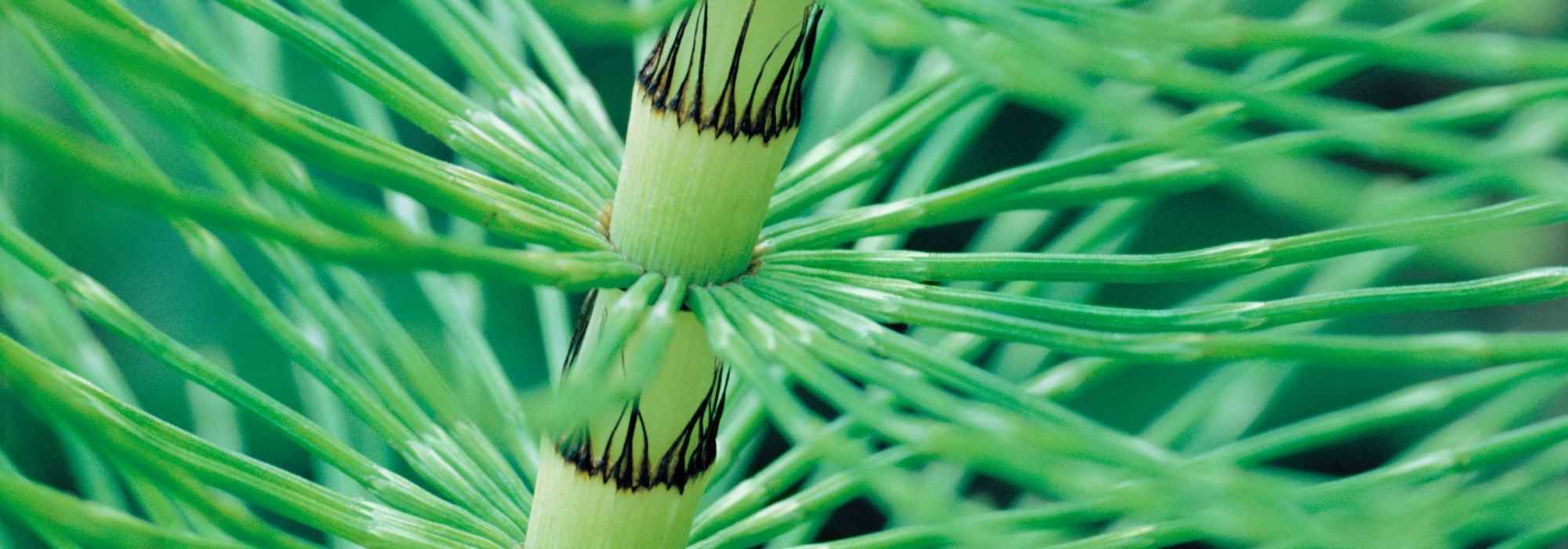
How to make horsetail manure?
Recipe and uses
Summary
Used in organic gardening, plant manures have many uses and beneficial effects on our ornamental and vegetable plants. Depending on plants used, they can be used both as fertilisers, organic biostimulants, repellents, compost activators and also as curative or preventive treatments for certain fungal diseases. The most ‘famous’ of the manures is, of course, nettle manure. However, a surprising number of wild plants, notably horsetail, can also be valuable as manures or decoctions. Discover how to make horsetail manure and its uses in the vegetable garden and orchard.
Which horsetail should I use?
To make manure or a decoction, people mainly use field horsetail (Equisetum arvense) but marsh horsetail (Equisetum palustre) can also be used. However, the latter contains less silica and is also used for medicinal purposes.
For more information on horsetail, consult our full sheet: Horsetail, Equisetum: planting, cultivation and care.
You may also read
Comfrey manure: recipe, use and benefitsWhat are the benefits of horsetail manure?
Properties of horsetail
Field horsetail is rich in minerals and notably in silicon dioxide, more commonly called silica. This strengthens plant tissues and stimulates their natural defences (known as an elicitor effect). Horsetail also contains a good proportion of potassium, promoting plant growth. Note that horsetail has antifungal and organic-stimulating action.
Conversely, horsetail manure is not a weedkiller.
Discover other Equisetum - Horsetail
View All →Available in 1 sizes
Available in 1 sizes
Available in 1 sizes
Available in 3 sizes
Available in 1 sizes
Where and when to harvest horsetail?
Field horsetail is found almost everywhere in nature: on damp, acidic soil… at edges of fields or paths, in ditches, in prairies or in gardens.
Sterile stems of field horsetail are harvested in June–July, when it is more developed and richer in minerals.
It can be used fresh or dried. However, prefer fresh field horsetail when making your manures to preserve all minerals and active compounds of the plant. In a decoction, it is mainly silica that is extracted. Silica is not altered by drying and, in that case, you can use either fresh or dried field horsetail.
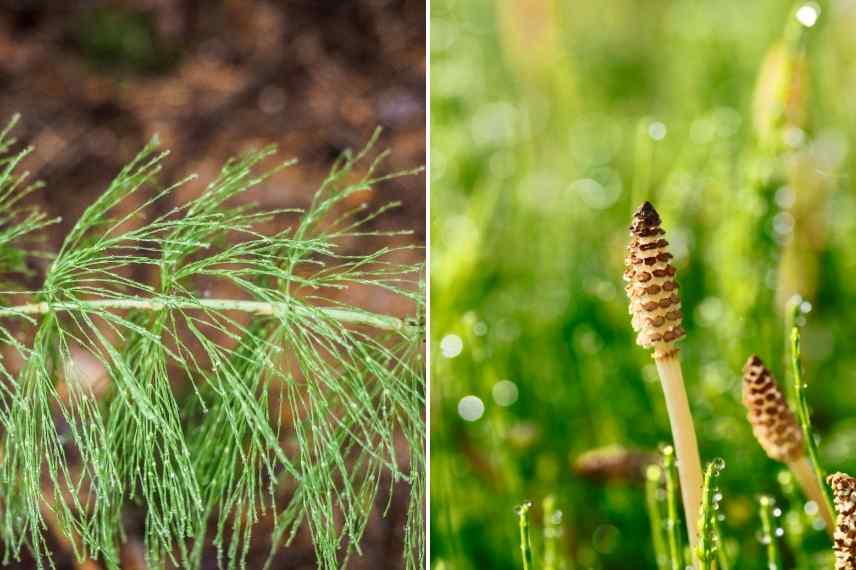
Field horsetail: sterile stem on left, and fertile stem ending with an oblong spike on right
You may also read
Nettle manure: how to make it?How to make horsetail manure?
Recipe for horsetail manure:
- You will need 1 kg horsetail and 10 litres of rainwater;
- Immerse horsetail, previously chopped with a pair of scissors or a pruning shear, in a bucket of rainwater (non-calcareous). The more finely the horsetail is cut, the more it will release its elements;
- Cover with a cloth (no lid), allowing air to circulate while keeping insects out;
- Stir every day, even twice a day, for about 10 days, using a stick. It is important to stir daily so the manure ferments rather than rots. Continue stirring as long as you see fermentation bubbles;
- Filter your plant extract first through an old sieve and then through a cloth (old fabric or stocking) to ensure good preservation;
- Transfer to an opaque, airtight container, taking care to fill it as fully as possible to avoid oxidation of the extract by ambient air.
Warning, never use a metal container as it oxidises and rapidly cancels the beneficial effects of active compounds contained in plant extracts.
Storage of horsetail manure
Fermented horsetail extract keeps for about 1 year, stored in a cool, dark place.
Where to find horsetail manure?
And for gardeners who don’t want the hassle, find ready-to-use horsetail manure in our online shop.
When and how to use horsetail manure?
Used from spring onwards to stimulate and strengthen immune defences. It can be used notably to prevent powdery mildew, downy mildew, scab, peach leaf curl, raspberry bacteriosis.
Note that it is also an effective repellent, particularly against mites and aphids.
How to treat with horsetail manure?
Highly concentrated, horsetail manure must not be used undiluted; it must be diluted.
- Dilute to 5–10% for spraying: for example, for a 5% dilution, in a 1-litre sprayer pour 50 cl of manure and top up with 950 cl of water. Use this dilution to strengthen young plants. However, at first signs of an attack by cryptogamic diseases, increase to a 10% dilution to help susceptible plants defend themselves: tomatoes, squashes, peach, apple, grapevine, rose… Spray every two weeks in dry, low-wind conditions early morning or late evening. It can also be used for watering at planting and transplanting for a stimulating action and to inhibit cryptogamic fungi that may be present in the soil.
- Dilute up to 20% for spraying from April on apple, pear and peach trees, until bud swelling (bud burst period).
Note that when you use it as a fertiliser (for watering, at the base of your plant), feel free to mix with comfrey manure or nettle manure to create a synergy and increase effectiveness.
In all cases, be sure to strictly observe recommended doses to avoid burning your plants during spraying or watering.
How to make horsetail decoction?
Horsetail decoction is quicker to prepare than manure.
- Immerse 100 g of coarsely chopped fresh horsetails or 20 g of dried horsetail in one litre of rain water ;
- Cover and let macerate for 24 hours ;
- Bring to the boil and simmer for 30 minutes over low heat ;
- Strain finely once the solution has cooled ;
- Pour into a sprayer.
Warning, prepare it only when needed because horsetail decoction does not keep over time and must be used within two weeks.
When and how to use horsetail decoction?
Dilute decoction to 10% before use, i.e. 1 litre of decoction to 9 litres of water.
Spray every 15 days from spring, before leaves appear in the orchard, then thereafter weekly until harvest of first fruits in late August.
This green extract is used for its fungicidal properties and is an effective ally in prevention or cure for minor attacks of cryptogamic diseases such as powdery mildew, scab, moniliosis (brown rot), rust, Botrytis, damping-off of sowings, peach leaf curl. It proves especially useful for orchard fruit trees (pears, apples, quinces, cherries) but also for certain vegetables (potatoes, cucurbits, alliums…).
- Subscribe!
- Contents

































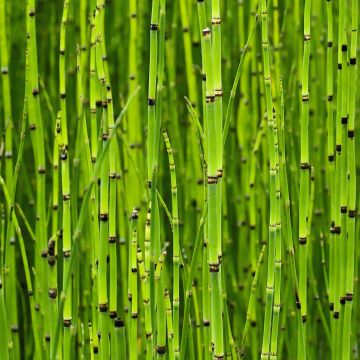
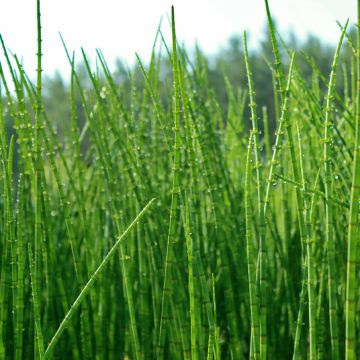
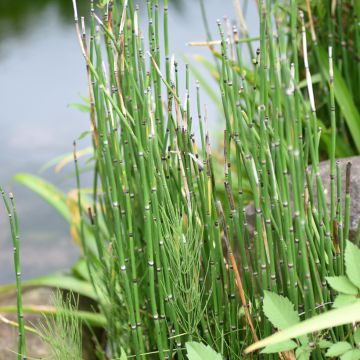
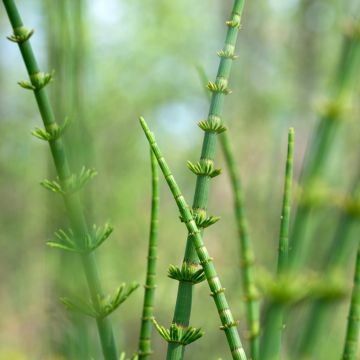
Feedbacks